The 2012 MacBook Air (11 & 13-inch) Review
by Anand Lal Shimpi on July 16, 2012 12:53 PM EST- Posted in
- Apple
- Mac
- MacBook Air
- Laptops
- Notebooks
The Display
The MacBook Air is really Apple's mass-market notebook, and as such it's not going to be the target for a Retina Display upgrade, at least not this year. While technically feasible, my guess is a lack of supply kept a rMBA out of the cards for this year. There's also the matter of maintaining its thin profile and battery life in pursuit of a retina display.
The MacBook Air display continues to be good, and better than most, but no where near what the rMBP delivers and actually a step behind what the competition in the PC space has been cooking up.
If there was one clear trend at Computex this year it's towards IPS 1080p displays in Windows 8 notebooks. ASUS actually pre-empted all of the exciting announcements (rMBP included) with its Zenbook Prime, complete with 11 and 13-inch 1080p IPS displays. As the MacBook Air retains its TN display, for the first time we can actually say that ASUS' Ultrabook offers better viewing angles than the Air. The difference is quite noticeable:
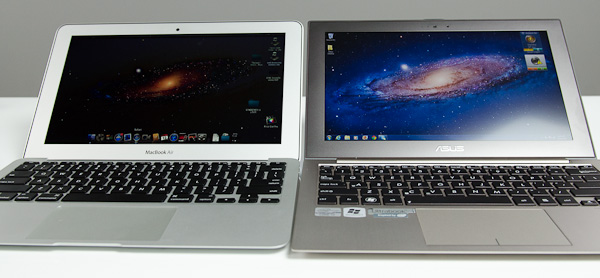
2012 MacBook Air (left) vs. 2012 ASUS Zenbook Prime (right)
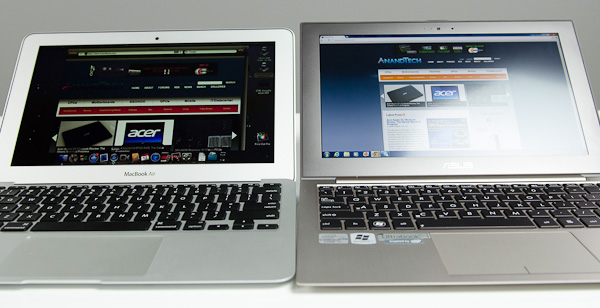
2012 MacBook Air (left) vs. 2012 ASUS Zenbook Prime (right)
ASUS also enjoys a resolution advantage, but it's not really high enough to make good use of integer DPI scaling (at 2x you get a UI sized for a 960 x 540 display). You get sharpness, and additional desktop area, but not the total package you get with the rMBP. There's no denying that what ASUS has done is better, it's just not perfect. And as Apple has shown us in the past, it's not fond of stopgap solutions.
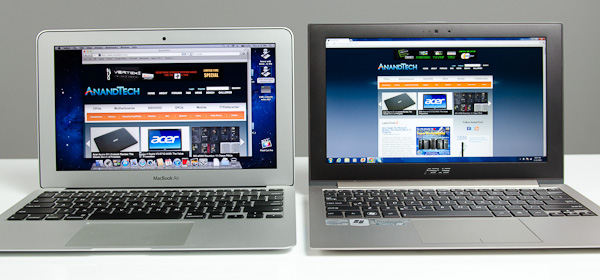
2012 MacBook Air (left) vs. 2012 ASUS Zenbook Prime (right)
Brightness, black levels, contrast, color accuracy and gamut haven't changed over the past year. The MacBook Air's panel remains one of the best non-IPS solutions on the market. The problem is that consumer insistence higher quality displays has pushed Apple's competitors to finally deliver more than TN at MacBook Air price points. Sooner rather than later, Apple will have to respond.
The Panel Lottery
Unlike in previous years, there appears to be three manufacturers supplying panels for the 2012 MacBook Air. LG Philips and Samsung return from before, but AUO now joins the fray. It's quite possible that Apple's volumes have grown large enough to justify adding a third supplier - a trend we may see increase in the future, and across more component categories.
As always, you can try to find out what panel is used in your MacBook Air by executing the following command in an OS X Terminal window:
ioreg -lw0 | grep IODisplayEDID | sed "/[^<]*</s///" | xxd -p -r | strings -6
The output will look something like this:

As long as Apple hasn't masked the data, the first line should be the part number of your display panel. The first one or two characters will tell you the manufacturer: LP for LG Philips, LT for Samsung and B for AUO. Anecdotally, LG and Samsung seem to be the most prevalent. In my personal experience with six 13-inch 2012 MacBook Airs and three 11-inch MacBook Airs, the breakdown was as follows:
13-inch $1499 - Samsung
13-inch $1499 - Samsung
13-inch $1499 - Samsung
13-inch $1499 - Samsung
13-inch $1499 - Samsung
13-inch $2199 - LG
11-inch $1099 - AUO
11-inch $1099 - AUO
11-inch $999 - Samsung
A thread over on Macrumors places the Samsung/LG split much closer to 50/50, however it's not clear if there's a higher incidence of LG panels in BTO or non-default configurations. We'd need many more samples to really get an idea for how all of this shapes up, so don't put too much faith in the results from my experience.
Apple does its best to ensure that all three panels deliver comparable performance, however there are differences. Let's first start with the numbers:
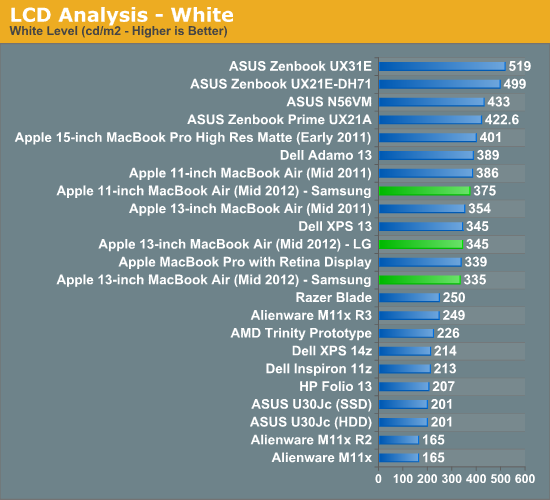
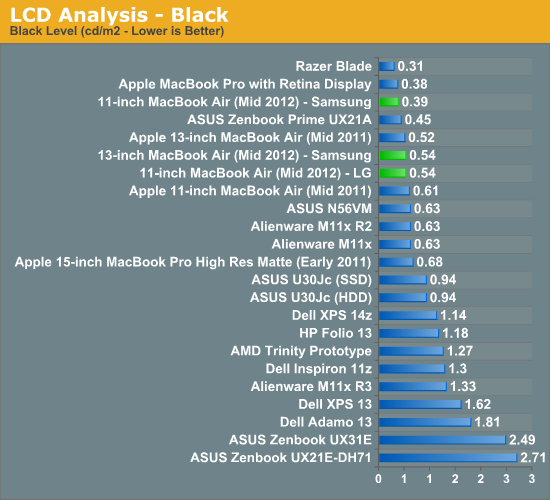
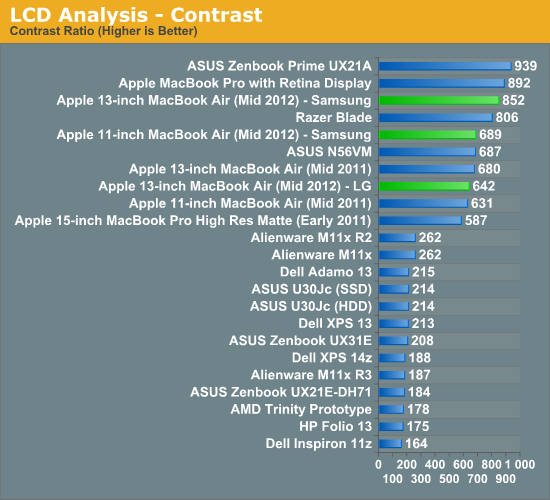
The 13-inch LG panel delivers tangibly worse black levels than the Samsung alternative. There's even a pretty dramatic difference in black levels between even the 11 and 13-inch Samsung panels. It's also possible that there's panel to panel variation at play here that would result in this sort of a difference.
The LG panel is a bit brighter, which helps it reach a decent contrast ratio but the 13-inch Samsung panel's low black levels give it an advantage. Interestingly enough, the 13-inch LG sample performed very similarly to the 11-inch Samsung. I really do wonder how much of this difference is just normal variance between panels.
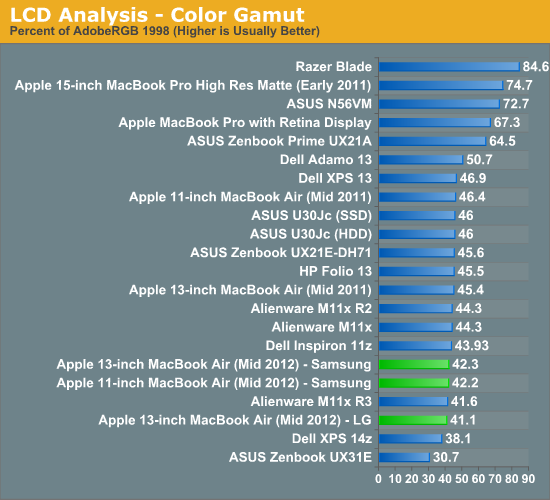
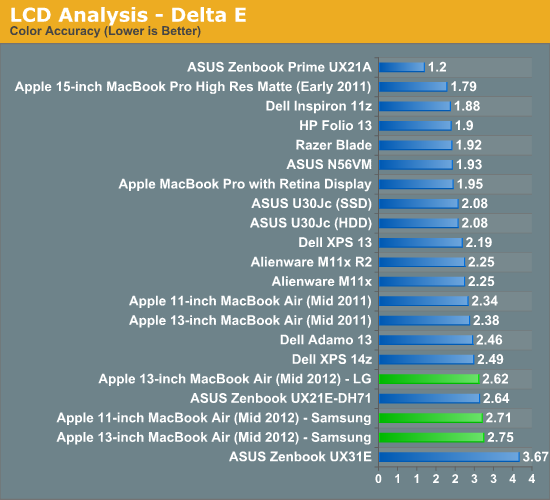
Color accuracy is slightly better on the LG panel, although it's not beyond the noticeable threshold. Color gamut is comparable between the displays.
Independently, neither the Samsung or LG panels is particularly bad to look at. These are still TN panels so you get poor vertical viewing angles, but the quality is still better than the cheaper TNs we often see used in less expensive notebooks. It's when you compare the two or you're used to one that you can really tell a difference: the Samsung panel, particularly when displaying black text on a white background, looks better than the LG.
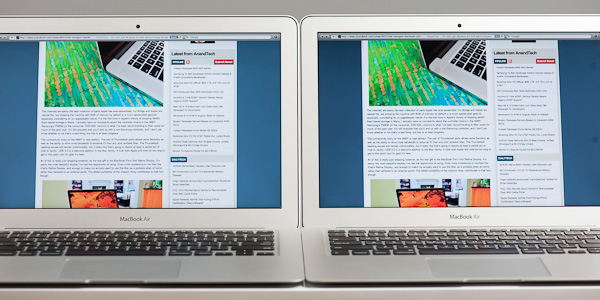
13-inch LG LP133WP1-TJA3 panel (left) vs. Samsung LTH133BT01A03 panel (right)
I had some friends over and tossed them a pair of 13-inch MBAs. One had the LG panel and one had the Samsung panel. They used the MBAs and swapped after a short while. Almost instantaneously they could tell the difference between the panels. Everyone significantly favored the Samsung.
I was actually a bit surprised how quickly they noticed the difference. With these type of things I always assume I'm just more sensitive than most, but in this case the difference was noticeable enough to pick out. Everyone added (and I agreed) that the difference was most pronounced because they were able to switch between two. In a vacuum each one seemed fine.
I tried my best to capture the difference between the two panels on camera. The easiest way to describe the difference is text on the Samsung panel just looks darker (mouse over the panel name in the table below):
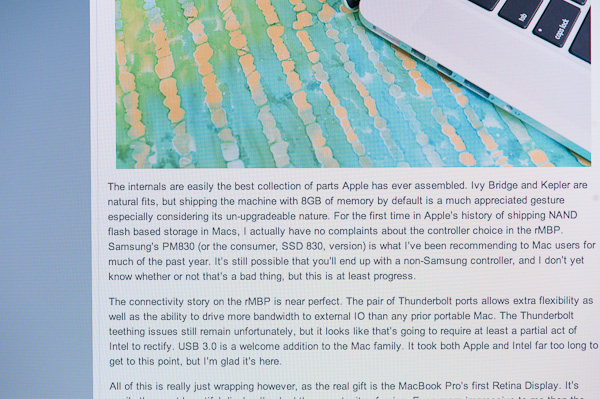
| LG LP133WP1-TJA3 | Samsung LTH133BT01A03 |
| original | original |
Just like last time, I believe the two panels behave differently in how they react to off-center viewing angles but I couldn't really capture the slight differences on camera. Although I didn't have an AUO equipped MBA on hand, the one I saw in an Apple store looked closer to the LG than the Samsung.
The good news is after a calibration pass using Color Eyes Display Pro, the difference between the two is significantly reduced - to the point where I can no longer tell the two apart:
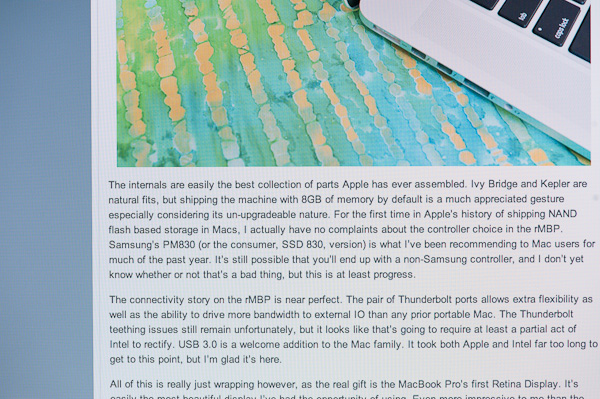
| LG LP133WP1-TJA3 | Samsung LTH133BT01A03 |
| original | original |
The obvious problem with this solution is you need access to a decent colorimeter or spectrophotometer and calibration software. There are some color profiles floating around the web that may help (I've uploaded mine for the LG here, Samsung here) but every panel is going to be at least somewhat different so this is still not perfect.
Subjectively, I'm fine with the LG panel, although I do like the look of the Samsung better. Both are a bit of a disappointment compared to what you get from the Retina Display in the MacBook Pro however. It's just presently what you give up for portability and cost.
To Make a Retina
The thing about the MacBook Air is that it's already quite minimized on the inside. The vast majority of the chassis is occupied by a battery, and there's no traditional HDD or optical drive to remove for additional space. Apple can't simply toss a much higher resolution panel on the system and call it a day, at least not without a tangible reduction in battery life.

13-inch MacBook Air (Mid 2012) - iFixit
Apple had to give the MacBook Pro with Retina Display a 95Wh battery (up from 77.5Wh) just to deliver similar battery life to the regular MacBook Pro. The higher resolution display requires a brighter backlight to push light through the panel and maintain comparable brightness levels.
The motherboard itself can stand to lose a single chip (the PCH) with the transition to Haswell, but that's not going to give us a ton of space either.
In the short term Apple could opt for a slightly thicker chassis (similar to what happened in the 3rd gen iPad) to accommodate a larger battery. Eventually the hope is that panel efficiency will increase to the point where we won't need significantly brighter backlights.


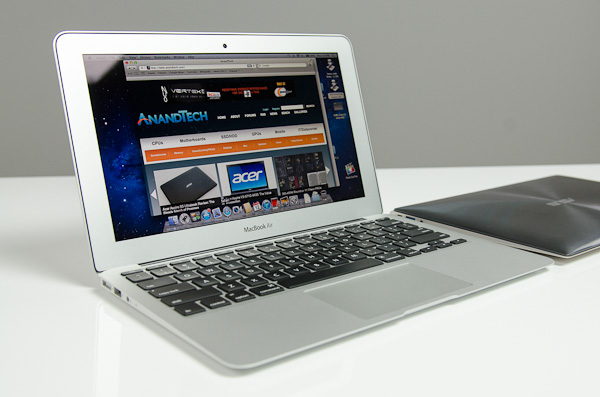








190 Comments
View All Comments
MrJim - Tuesday, July 17, 2012 - link
Thanks for the reply sir!I would like "ultra small form factor removable DRAM standards" and i think many of us would. But it also seems for me that this is part of a corporate strategy, car makers have done this for years. "You can only buy stuff from us, good quality we promise, and of course alot more expensive than some of the other 200 makers of that perticulur car engine part".
To say the least for changing batteries. And i did expect you to sit on information that we ordinary people doesnt have. Im looking forward to the future, but i like choice thats all.
Karltheghost - Tuesday, July 17, 2012 - link
Sure you're right. If i buy a Notebook, it is less serviceable than a full size desktop PC. And if i buy an Ultrabook it is even less serviceable. But being able to change the only wearing part in an expensive part of Elecronics, that is not likely to last as long as the rest of the Laptop is the least i want to do. By the way it's the same for Smartphones. I just don't want to buy a product which i need to replace completely if the battery wears out because i cannot change it myself and having it replaced is nearly as expensive as a new Laptop/Smartphone. And because there are manufactors who sell Smartphones and Ultrabooks with changeable batteries, your argument, as far as it goes to batteries, is not very convincing. As for other parts you're right, demanding switchable CPUs or something like that in an Ultrabook would be hilarious.KPOM - Tuesday, July 17, 2012 - link
There are more and more Ultrabooks sold with non removable batteries now. The Samsung Series 9 is one example.Tegeril - Monday, July 16, 2012 - link
"Very disappointed Anand. Very disappointed with you."Hilarious.
The MBA is still a class leading entry in the ultraportable market. It no longer wins in every single category (see: display), but that does not mean it is not a great system.
You ignore things like consumer SSDs being consumer SSDs in large packages without custom manufacturing. Apple's memory upgrades have always been more expensive than retail and have actually come closer to reality recently. But again, this is not a stick of mass produced memory, it's not an apples to apples comparison. As far as overcharging in any other area of the system, you fail to accurately include chassis, trackpad, magsafe, and other superior elements that can't be compared in the way you want to do spec to spec comparisons.
Being melodramatic about this review is what's disappointing. It very accurately describes why Apple is selling these and their pro systems so much more successfully than in the past. They're very good systems.
KoolAidMan1 - Monday, July 16, 2012 - link
The Apple haters are out in force, as usual.So mad.
Karltheghost - Tuesday, July 17, 2012 - link
So everyone who criticises Apple is automatically a hater? Seems like you're as differenciating as the haters . . . In fact, there are plenty of people out there who had an apple product and are therefore not very fond of apple. For example i bought an Ipod because i wanted a good Mp3-player. It did everything except from playing Mp3s in a proper way and i wasn't the only one who had this issue (Referring to an Ipod nano 3g, the bad sound without equalizer and the scratching noises with equalizer turned on).And i know a lot of people who sold their Macbook Pros 2 weeks after purchasing and bought regular windows machines because there are flaws that the technical specs don't reveal . . .
KPOM - Tuesday, July 17, 2012 - link
"Macs are garbage and I should know because I bought an iPod once and it didn't work right, plus my friend returned a MacBook Pro 2 weeks after buying it." These are anecdotes.It's OK to criticize Apple. Heck, the original MacBook Air got a lot of criticism from hard core Mac fans when it first came out. However, few company's products inspire the fierce criticism that anything Apple puts out does.
I get the sense that if Apple stuck its logo on hardware completely identical to an ASUS Zenbook or Samsung Series 9, there would be 6 pages of comments on this site from many of the Apple bashers criticizing every little flaw, but when the actual product reviews come out those same people won't be posting anything but praise for the product.
Karltheghost - Tuesday, July 17, 2012 - link
Of course that are anecdotes, hence i wrote "For example" at the beginning . . .But actually i rely more on my personal experience and that of others, by whom i know what they're doing with their stuff than on some fanboyspeech (this is not intendet as criticism for this review). What i can say is that i made bad experiences with apple and friends too and there are much more bad experiences than good ones. So i am very sceptical. On the other hand i had very bad experiences with other brands too (e.g. i had 2 HP Notebooks that lastet less than 3 months), but there are plenty of others who hadn't problems for years. So what i'm referring to is kind of a good/bad-balance . . .
It's not that i wouldn't buy a product just because it has an apple on it. In fact i would buy one if it fulfills my needs. But as long they're charging premium prices for machines that you can literarily throw away as soon the warranty runs out and have horrible software restrictions i'll stick with the bulky, ugly things that other manufactures are producing
KPOM - Tuesday, July 17, 2012 - link
What makes an Apple a throwaway product after a year? It still functions. My sister has a 2006 MacBook that is in almost new condition (though she hasn't used it much since getting a 2011 MacBook Air).Also, there are no software restrictions on OS X. Even with Mountain Lion, you can purchase and install your own software. This isn't iOS or Windows RT, where you must purchase from an App Store. The Mac App Store is optional.
Sure, it won't run Windows as good as a PC with the same specs will, but it will run pretty well. I think what most Mac users who run Windows find is that over time, they use Windows less and less, perhaps just for that old program that just doesn't have a Mac equivalent. Heck, even Windows 7 includes an "XP Mode" to run XP in virtualization, so it isn't unique to the Mac. I can quibble a lot about how Microsoft has "crippled" support for 16-bit apps, or how the 64-bit version dropped support for some old peripheral that worked just fine in XP.
Karltheghost - Tuesday, July 17, 2012 - link
Just personal experience. After 2 Years or so most products get faulty, even if it's just the battery or a fan. On most Apple products you can't change that yourself as it's tightly integrated in the system and for example, a friend of mine payed 170€ just for a new iphone battery . Thats a financial write-of.With software restrictions i was referring to the windows/linux thing. The only reason windows runs slow is that apple provides bad drivers so you stick with osx.
A bunch of horses won't get me to use OSX, i tried it once and it felt like a cage where the restrictions are covered by a lot bling-bling animation. While there are some nice things about it, like the touchpad integration you have even less system access than under windows. Nothing to convince a linux user and also nothing to replace windows on the gaming machine ;)
The license agreement does the rest (yeah, i actually read that thing)